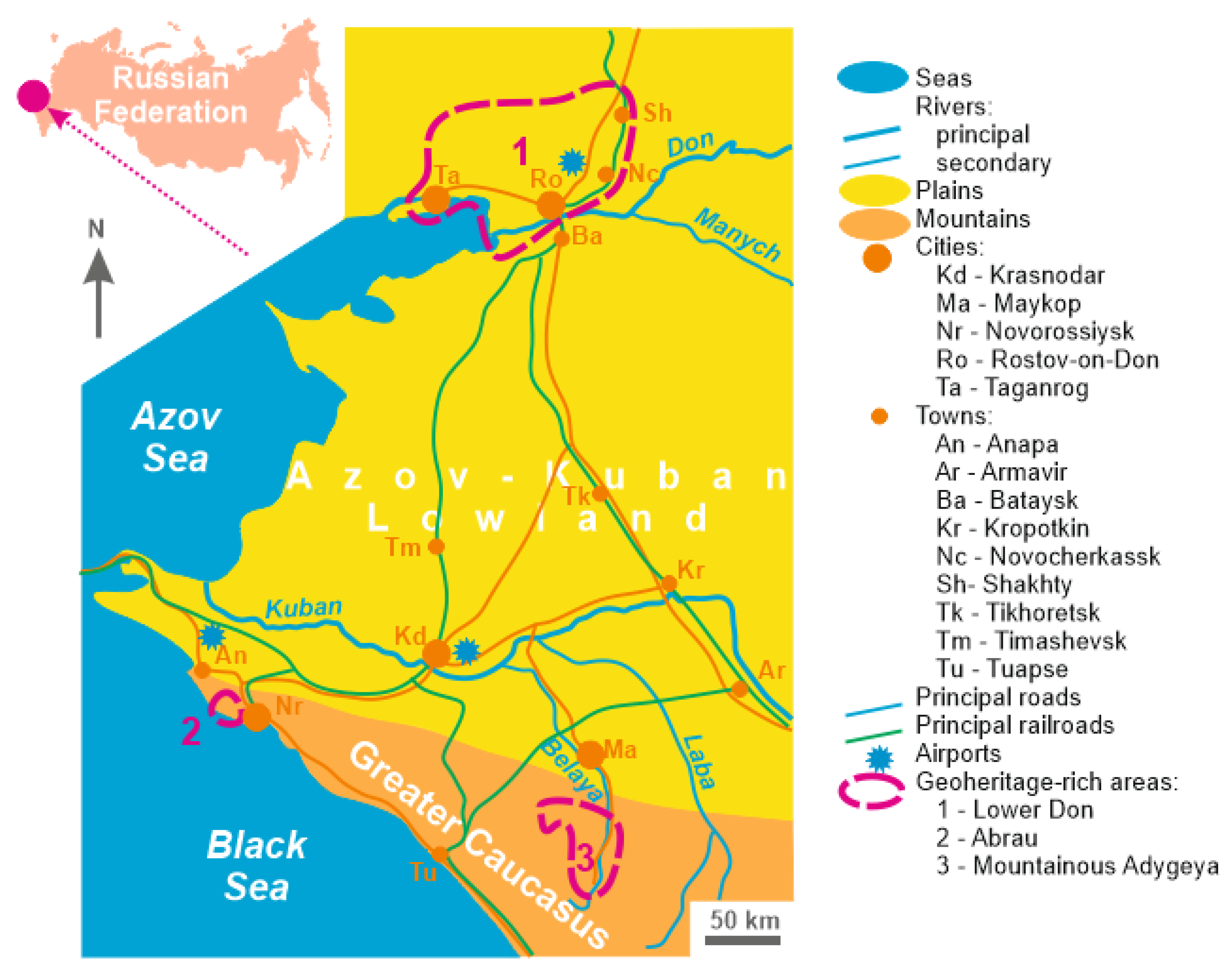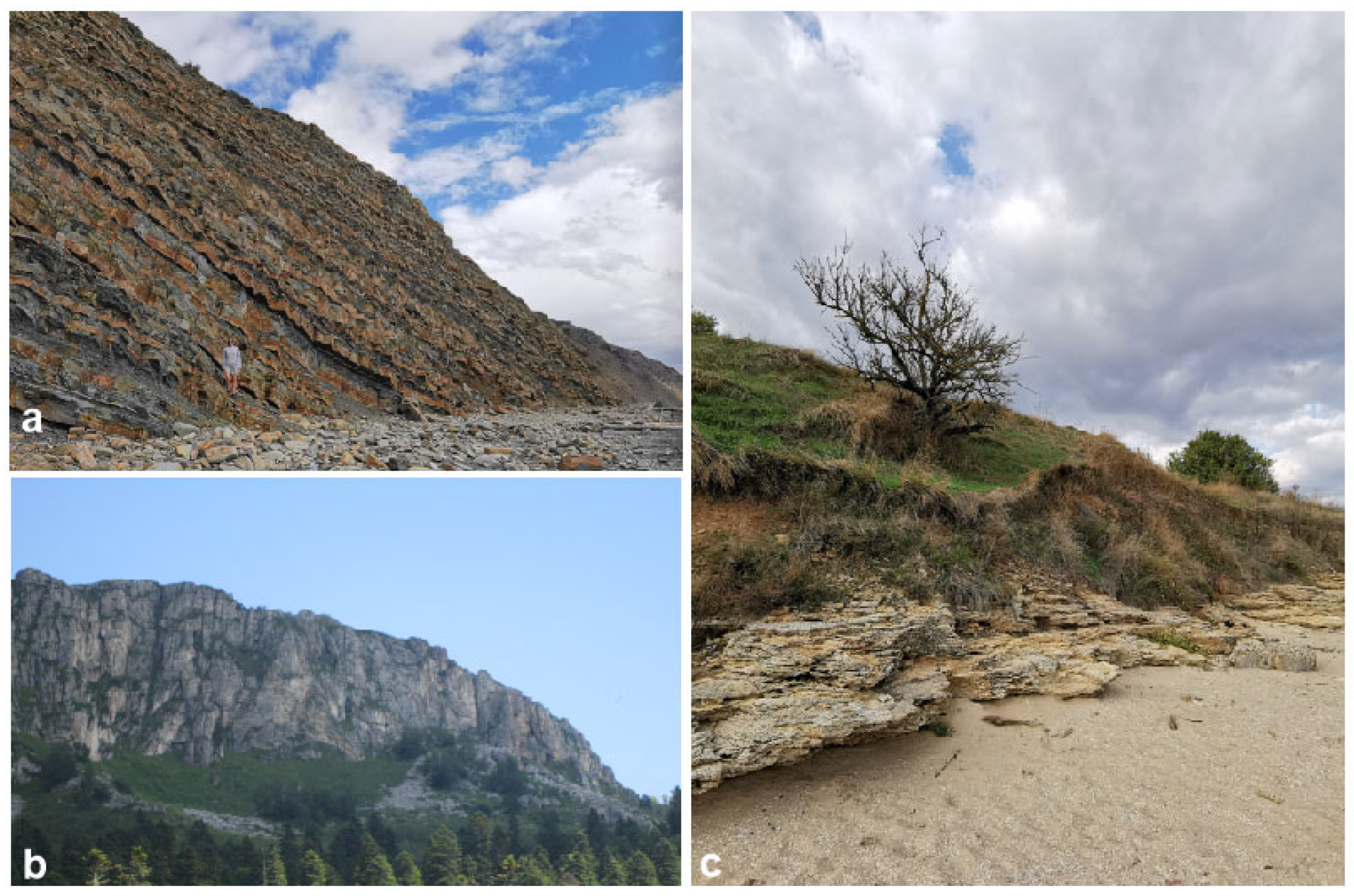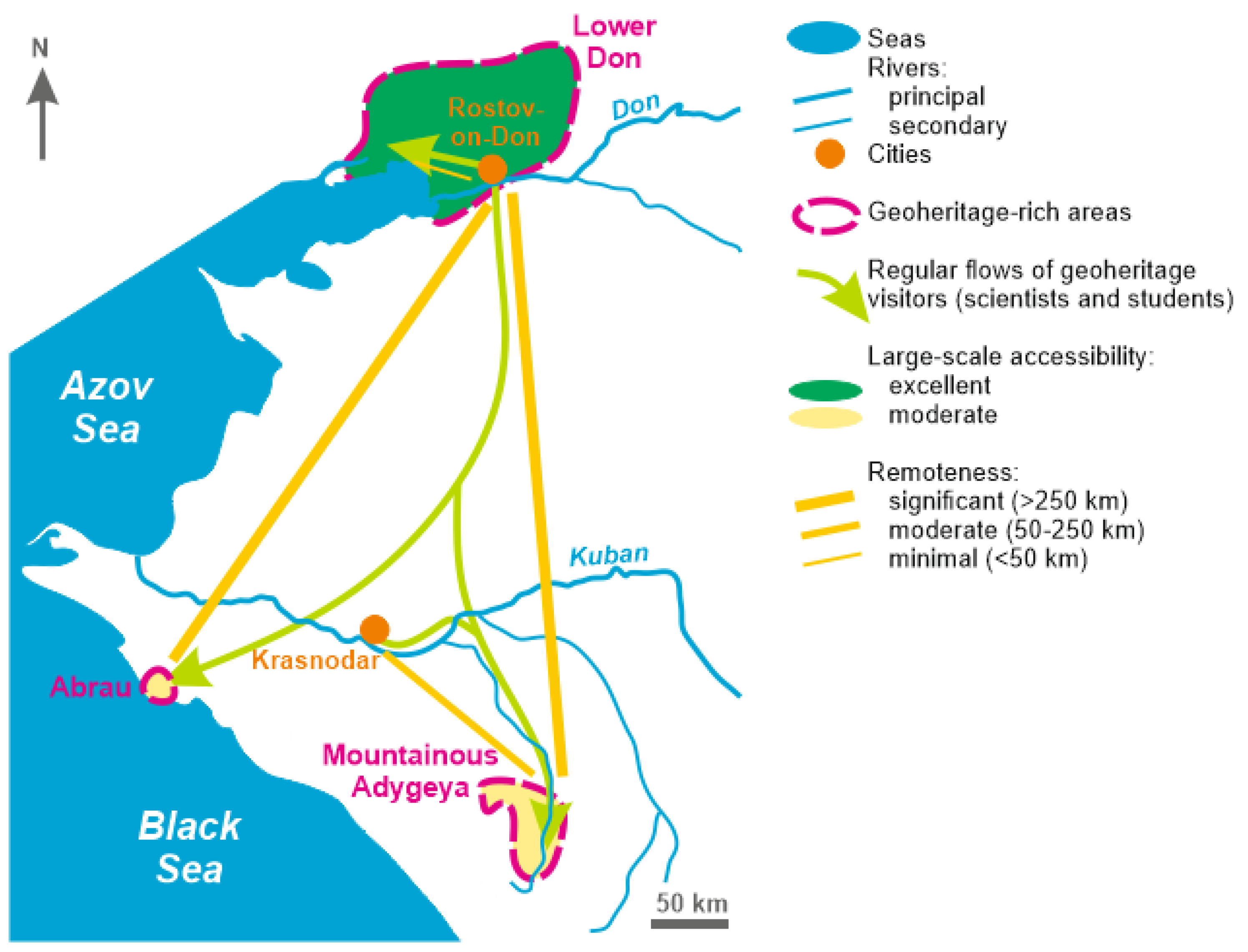Large-Scale Accessibility as a New Perspective for Geoheritage Assessment
Abstract
1. Introduction
2. Study Territory
3. Material and Methods
4. Results
5. Discussion and Conclusions
Author Contributions
Funding
Institutional Review Board Statement
Informed Consent Statement
Data Availability Statement
Conflicts of Interest
References
- Brocx, M.; Semeniuk, V. Geoheritage and geoconservation—History, definition, scope and scale. J. R. Soc. West. Aust. 2007, 90, 53–87. [Google Scholar]
- Henriques, M.H.; dos Reis, R.P.; Brilha, J.; Mota, T. Geoconservation as an emerging geosciences. Geoheritage 2011, 3, 117–128. [Google Scholar] [CrossRef]
- Herrera-Franco, G.; Carrión-Mero, P.; Montalván-Burbano, N.; Caicedo-Potosí, J.; Berrezueta, E. Geoheritage and Geosites: A Bibliometric Analysis and Literature Review. Geosciences 2022, 12, 169. [Google Scholar] [CrossRef]
- Kaur, G. Geodiversity, Geoheritage and Geoconservation: A Global Perspective. J. Geol. Soc. India 2022, 98, 1221–1228. [Google Scholar] [CrossRef]
- Neto, K.; Henriques, M.H. Geoconservation in Africa: State of the art and future challenges. Gondwana Res. 2022, 110, 107–113. [Google Scholar] [CrossRef]
- Pijet-Migoń, E.; Migoń, P. Geoheritage and Cultural Heritage—A Review of Recurrent and Interlinked Themes. Geosciences 2022, 12, 98. [Google Scholar] [CrossRef]
- Reynard, E.; Brilha, J. (Eds.) Geoheritage: Assessment, Protection, and Management; Elsevier: Amsterdam, The Netherlands, 2018. [Google Scholar]
- Urban, J.; Radwanek-Bąk, B.; Margielewski, W. Geoheritage Concept in a Context of Abiotic Ecosystem Services (Geosystem Services)—How to Argue the Geoconservation Better? Geoheritage 2022, 14, 54. [Google Scholar] [CrossRef]
- Williams, M.A.; McHenry, M.T.; Boothroyd, A. Geoconservation and Geotourism: Challenges and Unifying Themes. Geoheritage 2020, 12, 63. [Google Scholar] [CrossRef]
- Xu, K.; Wu, W. Geoparks and Geotourism in China: A Sustainable Approach to Geoheritage Conservation and Local Development—A Review. Land 2022, 11, 1493. [Google Scholar] [CrossRef]
- Bétard, F.; Hobléa, F.; Portal, C. Geoheritage as new territorial resource for local development. Ann. Geogr. 2017, 717, 523–543. [Google Scholar] [CrossRef]
- Garcia, M.D.G.; Queiroz, D.S.; Mucivuna, V.C. Geological diversity fostering actions in geoconservation: An overview of Brazil. Int. J. Geoheritage Park. 2022, 10, 507–522. [Google Scholar] [CrossRef]
- Henriques, M.H.; Castro, A.R.S.F.; Félix, Y.R.; Carvalho, I.S. Promoting sustainability in a low density territory through geoheritage: Casa da Pedra case-study (Araripe Geopark, NE Brazil). Resour. Policy 2020, 67, 101684. [Google Scholar] [CrossRef]
- Ruban, D.A.; Mikhailenko, A.V.; Yashalova, N.N. Valuable geoheritage resources: Potential versus exploitation. Resour. Policy 2022, 77, 102665. [Google Scholar] [CrossRef]
- Santangelo, N.; Valente, E. Geoheritage and Geotourism resources. Resources 2020, 9, 80. [Google Scholar] [CrossRef]
- Unjah, T.; Yusry, M.; Simon, N. Identification and characterization of geoheritage resources at Hulu Langat, Selangor. Bull. Geol. Soc. Malays. 2021, 72, 191–204. [Google Scholar] [CrossRef]
- Štrba, L.; Rybar, P.; Balaz, B.; Molokac, M.; Hvizdak, L.; Krsak, B.; Lukac, M.; Muchova, L.; Tometzova, D.; Ferencikova, J. Geosite assessments: Comparison of methods and results. Curr. Issues Tour. 2015, 18, 496–510. [Google Scholar] [CrossRef]
- Bétard, F.; Peulvast, J.-P. Geodiversity Hotspots: Concept, Method and Cartographic Application for Geoconservation Purposes at a Regional Scale. Environ. Manag. 2019, 63, 822–834. [Google Scholar] [CrossRef]
- da Silva, J.C.; dos Santos, D.S.; da Rocha, T.B. Identifying geomorphological diversity hotspots for conservation purposes: Application to a coastal protected area in Rio de Janeiro State, Brazil. Appl. Geogr. 2022, 142, 102689. [Google Scholar] [CrossRef]
- Gray, M. Geodiversity: Developing the paradigm. Proc. Geol. Assoc. 2008, 119, 287–298. [Google Scholar] [CrossRef]
- Frassi, C.; Amorfini, A.; Bartelletti, A.; Ottria, G. Popularizing Structural Geology: Exemplary Structural Geosites from the Apuan Alps UNESCO Global Geopark (Northern Apennines, Italy). Land 2022, 11, 1282. [Google Scholar] [CrossRef]
- Brilha, J. Inventory and quantitative assessment of geosites and geodiversity sites: A review. Geoheritage 2016, 8, 119–134. [Google Scholar] [CrossRef]
- Warowna, J.; Zgłobicki, W.; Kołodyńska-Gawrysiak, R.; Gajek, G.; Gawrysiak, L.; Telecka, M. Geotourist values of loess geoheritage within the planned Geopark Małopolska Vistula River Gap, E Poland. Quat. Int. 2016, 399, 46–57. [Google Scholar] [CrossRef]
- Mikhailenko, A.V.; Ruban, D.A.; Ermolaev, V.A. Accessibility of Geoheritage Sites—A Methodological Proposal. Heritage 2021, 4, 1080–1091. [Google Scholar] [CrossRef]
- Cheablam, O.; Tansakul, P.; Nantakat, B.; Pantaruk, S. Assessment of the Geotourism Resource Potential of the Satun UNESCO Global Geopark, Thailand. Geoheritage 2021, 13, 87. [Google Scholar] [CrossRef]
- Deng, L.; Zou, F. Orogenic belt landforms of Huanggang Dabieshan UNESCO Global Geopark (China) from geoheritage, geoconservation, geotourism, and sustainable development perspectives. Environ. Earth Sci. 2021, 80, 662. [Google Scholar] [CrossRef]
- Henriques, M.H.; Canales, M.L.; García-Frank, A.; Gomez-Heras, M. Accessible Geoparks in Iberia: A Challenge to Promote Geotourism and Education for Sustainable Development. Geoheritage 2019, 11, 471–484. [Google Scholar] [CrossRef]
- Rais, J.; Barakat, A.; Louz, E.; Ait Barka, A. Geological heritage in the M’Goun geopark: A proposal of geo-itineraries around the Bine El Ouidane dam (Central High Atlas, Morocco). Int. J. Geoheritage Park. 2021, 9, 242–263. [Google Scholar] [CrossRef]
- Wang, J.; Zouros, N. Educational Activities in Fangshan UNESCO Global Geopark and Lesvos Island UNESCO Global Geopark. Geoheritage 2021, 13, 51. [Google Scholar] [CrossRef]
- Bruno, D.E.; Perrotta, P. A geotouristic proposal for Amendolara territory (northern ionic sector of Calabria, Italy). Geoheritage 2012, 4, 139–151. [Google Scholar] [CrossRef]
- Camino, M.A.; Halpern, K.; Bó, M.J.; Meroi Arcerito, F.R. Sierra Bachicha: Proposal for a new site of geological interest in the Balcarce district, province of Buenos Aires. Ser. Correl. Geol. 2018, 34, 5–14. [Google Scholar]
- Lirer, L.; Petrosino, P.; Armiero, V. A proposal of some geosites in the framework of a new geological map of Campi Flegrei. Alp. Mediterr. Quat. 2008, 21, 39–46. [Google Scholar]
- Ranjbaran, M.; Sotohian, F. Development of Haraz Road geotourism as a key to increasing tourism industry and promoting geoconservation. Geopersia 2021, 11, 61–79. [Google Scholar]
- Štrba, L.; Baláž, B.; Lukác, M. Roadside geotourism—An alternative approach to geotourism. E-Rev. Tour. Res. 2016, 13, 598–609. [Google Scholar]
- Andreyanova, S.; Ivolga, A. The tourism potential of the North Caucasus: The formation, characteristics and development prospects. Geoj. Tour. Geosites 2018, 22, 347–358. [Google Scholar]
- Ivlieva, O.V.; Shmytkova, A.V.; Sukhov, R.I.; Kushnir, K.V.; Grigorenko, T.N. Assessing the tourist and recreational potential in the South of Russia. E3S Web Conf. 2020, 208, 05013. [Google Scholar] [CrossRef]
- Oborin, M.S.; Kozhushkina, I.; Gvarliani, T.; Ivanov, N. Socio-economic preconditions of resort agglomerations development in the south of Russia. Worldw. Hosp. Tour. 2018, 10, 467–477. [Google Scholar] [CrossRef]
- Nebabina, E.I.; Ruban, D.A. Geological Heritage Sites in the Southwest Rostov Region; RGU: Rostov-na-Donu, Russia, 2006. (In Russian) [Google Scholar]
- Ruban, D.A. On the Duality of Marine Geoheritage: Evidence from the Abrau Area of the Russian Black Sea Coast. J. Mar. Sci. Eng. 2021, 9, 921. [Google Scholar] [CrossRef]
- Ivanitskaya, V.B.; Pogrebnov, N.I. Geological Structure of the Lower Don and Lower Volga; RGU: Rostov-na-Donu, Russia, 1962. (In Russian) [Google Scholar]
- Hasterok, D.; Halpin, J.A.; Collins, A.S.; Hand, M.; Kreemer, C.; Gard, M.G.; Glorie, S. New Maps of Global Geological Provinces and Tectonic Plates. Earth-Sci. Rev. 2022, 231, 104069. [Google Scholar] [CrossRef]
- Baraboshkin, E.Y.; Bondarenko, N.A.; Lyubimova, T.V. Unique Geological Objects of the North-Western Caucasus; KubGU: Krasnodar, Russia, 2012. (In Russian) [Google Scholar]
- Van Hinsbergen, D.J.J.; Torsvik, T.H.; Schmid, S.M.; Matenco, L.C.; Maffione, M.; Vissers, R.L.M.; Gürer, D.; Spakman, W. Orogenic architecture of the Mediterranean region and kinematic reconstruction of its tectonic evolution since the Triassic. Gondwana Res. 2020, 81, 79–229. [Google Scholar] [CrossRef]
- Nazarenko, O.V.; Mikhailenko, A.V.; Smagina, T.A.; Kutilin, V.S. Natural Conditions of Mountainous Adygeya; SFU: Rostov-on-Don, Russia, 2020. (In Russian) [Google Scholar]
- Adamia, S.; Alania, V.; Chabukiani, A.; Kutelia, Z.; Sadradze, N. Great Caucasus (Cavcasioni): A long-lived north-tethyan back-arc basin. Turk. J. Earth Sci. 2011, 20, 611–628. [Google Scholar] [CrossRef]
- Lordkipanidze, M.B.; Adamia, S.A.; Asanidze, B.Z. Evolution of the active margins of the ocean Tethys (by example of the Caucasus). In Oceanology: Reports. 27 International Geological Congress, 3rd ed.; Lisitsin, A.P., Ed.; Nauka: Moscow, Russia, 1984; pp. 72–83. (In Russian) [Google Scholar]
- AbdelMaksoud, K.M.; Emam, M.; Al Metwaly, W.; Sayed, F.; Berry, J. Can innovative tourism benefit the local community: The analysis about establishing a geopark in Abu Roash area, Cairo, Egypt. Int. J. Geoheritage Park. 2021, 9, 509–525. [Google Scholar] [CrossRef]
- Brilha, J.; Gray, M.; Pereira, D.I.; Pereira, P. Geodiversity: An integrative review as a contribution to the sustainable management of the whole of nature. Environ. Sci. Policy 2018, 86, 19–28. [Google Scholar] [CrossRef]
- Kubalíková, L. Cultural ecosystem services of geodiversity: A case study from Stranska skala (Brno, Czech Republic). Land 2020, 9, 105. [Google Scholar] [CrossRef]
- Pereira Balaguer, L.; da Glória Motta Garcia, M.; de Almeida Leite Ribeiro, L.M. Combined Assessment of Geodiversity As a Tool to Territorial Management: Application to Southeastern Coast of State of São Paulo, Brazil. Geoheritage 2020, 14, 60. [Google Scholar] [CrossRef]
- Freire-Lista, D.M.; Becerra Becerra, J.E.; Simões de Abreu, M. The historical quarry of Pena (Vila Real, north of Portugal): Associated cultural heritage and reuse as a geotourism resource. Resour. Policy 2022, 75, 102528. [Google Scholar] [CrossRef]
- Bentivenga, M.; Cavalcante, F.; Mastronuzzi, G.; Palladino, G.; Prosser, G. Geoheritage: The Foundation for Sustainable Geotourism. Geoheritage 2019, 11, 1367–1369. [Google Scholar] [CrossRef]
- Kubalíková, L.; Bajer, A.; Balková, M.; Kirchner, K.; Machar, I. Geodiversity Action Plans as a Tool for Developing Sustainable Tourism and Environmental Education. Sustainability 2022, 14, 6043. [Google Scholar] [CrossRef]
- Somma, R. The Inventory and Quantitative Assessment of Geodiversity as Strategic Tools for Promoting Sustainable Geoconservation and Geo-Education in the Peloritani Mountains (Italy). Educ. Sci. 2022, 12, 580. [Google Scholar] [CrossRef]
- Diaz-Soria, I. Being a tourist as a chosen experience in a proximity destination. Tour. Geogr. 2017, 19, 96–117. [Google Scholar] [CrossRef]
- Larsen, J. Tourism mobilities and the travel glance: Experiences of being on the move. Scand. J. Hosp. Tour. 2001, 1, 80–98. [Google Scholar] [CrossRef]
- Tjørve, E.; Flognfeldt, T.; Tjørve, K.M.C. The Effects of Distance and Belonging on Second-Home Markets. Tour. Geogr. 2013, 15, 268–291. [Google Scholar] [CrossRef]



| Characteristics | Geoheritage-Rich Areas | ||
|---|---|---|---|
| Lower Don | Abrau | Mountainous Adygeya | |
| Location (administrative affinity) | Rostov Region | Krasnodar Region | Republic of Adygeya and Krasnodar Region |
| Approximate size | >10,000 km2 | 300 km2 | >2000 km2 |
| Geographical domain | Hilly plain, alluvial plain, seashore | Low mountains, seashore | Low and high mountains |
| Dominating landscape | Steppe (grassland) | Deciduous forests | Deciduous, mixed, coniferous forests |
| Number of geosites | >20 (inventory in progress) | 2 | 16 |
| Dominance of geosites | Low | Moderate | Moderate |
| Number of geoheritage types | 14 | 7 | 14 |
| Selected attractive features | Neogene outcrops with fossils, mud lakes, coal waste heaps | Cretaceous–Paleogene outcrops with trace fossils, lakes | Permian–Cretaceous outcrops with fossils, Paleozoic granitoids, waterfalls |
| Use in geoscience research | Low | Moderate | High |
| Use in geoscience education | Moderate | High | High |
| Use in geotourism | Low | Low | Moderate |
| Biodiversity | Low | Low | High |
| Human intervention | High (urbanization) | Moderate (touristic infrastructure) | Moderate (touristic infrastructure) |
| Landscape aesthetic attractiveness | High | High | High |
| Typical geosite visitors | University students and lecturers | Researchers, university students, and lecturers | Researchers, university students, and lecturers; geology amateurs and other geotourists |
| Criteria | Grades | Scores |
|---|---|---|
| External public transportation | ||
| Airport | Within area | 10 |
| <50 km from area | 7 | |
| 50–200 km from area | 2 | |
| >200 km from area | 0 | |
| Railway station | Within area | 10 |
| <50 km from area | 7 | |
| 50–200 km from area | 2 | |
| >200 km from area | 0 | |
| Bus station | Within area | 10 |
| <50 km from area | 5 | |
| 50–200 km from area | 2 | |
| >200 km from area | 0 | |
| Port (river/lake/sea) | Within area | 10 |
| <50 km from area | 5 | |
| 50–200 km from area | 2 | |
| >200 km from area | 0 | |
| Internal public transportation | ||
| Minor stops of trains, buses, boats in area | Numerous | 20 |
| Few | 10 | |
| Absent | 0 | |
| Road infrastructure | ||
| Best available road to area | Principal (paved) | 20 |
| Secondary (paved) | 15 | |
| Unpaved | 5 | |
| Absent | 0 | |
| Prevailed roads within area | Principal (paved) | 20 |
| Secondary (paved) | 15 | |
| Unpaved | 7 | |
| Absent | 0 | |
| Local services | ||
| Accommodation | Wide choice (numerous hotels, lodges, camps of different quality) within area | 30 |
| Wide choice (numerous hotels, lodges, camps of different quality) <50 km from area | 15 | |
| Limited choice (few hotels, lodges, camps offering elementary services) within area | 15 | |
| Limited choice (few hotels, lodges, camps offering elementary services) <50 km from area | 5 | |
| Absent | 0 | |
| Car/boat rental | Within area | 10 |
| <50 km or too limited | 5 | |
| >50 km or absent | 0 | |
| Taxi | Within area | 30 |
| <50 km | 15 | |
| >50 km or absent | 0 | |
| Excursion bus rental | Within area | 20 |
| <50 km or too limited | 5 | |
| >50 km or absent | 0 | |
| Meals | Big choice (numerous restaurants and cafes) within area | 30 |
| Limited choice (few restaurants and cafes) within area | 10 | |
| Absent | 0 | |
| General setting | ||
| Maximum rank of settlements within area | City (population >0.2 mln) | 30 |
| Town (population <0.2 mln) | 10 | |
| Village (population <5000) | 5 | |
| absent | 0 | |
| Seasonality in area | Unimportant for accessibility | 50 |
| Somewhat important for accessibility | 25 | |
| Important for accessibility | 5 | |
| Severe weather conditions in area | Rare (<1 event per year) | 20 |
| Common (1–5 events per year) | 10 | |
| Frequent (>5 events per year) | 0 | |
| Permissions for visiting area or its significant parts | Not required | 15 |
| Required | 0 | |
| Fees/tickets for visiting area or its significant parts | Not required | 15 |
| Required | 0 | |
| Grades of geoheritage-rich areas by their large-scale accessibility | ||
| CATEGORY | TOTAL SCORES | |
| Excellent | 251–350 | |
| Moderate | 151–250 | |
| Limited | 0–150 | |
| Criteria | Geoheritage-Rich Areas | ||
|---|---|---|---|
| Lower Don | Abrau | Mountainous Adygeya | |
| Airport | 10 | 2 | 2 |
| Railway station | 10 | 7 | 2 |
| Bus station | 10 | 10 | 10 |
| Port | 10 | 5 | 0 |
| Minor stops of trains, buses, boats in area | 20 | 0 | 10 |
| Best available road to area | 20 | 15 | 20 |
| Prevailed roads within area | 15 | 7 | 15 |
| Accommodation | 30 | 30 | 30 |
| Car/boat rental | 10 | 5 | 0 |
| Taxi | 30 | 30 | 30 |
| Excursion bus rental | 20 | 5 | 5 |
| Meals | 30 | 30 | 10 |
| Maximum rank of settlements within area | 30 | 5 | 10 |
| Seasonality in area | 25 | 25 | 25 |
| Severe weather conditions in area | 10 | 10 | 10 |
| Permissions (e.g., to natural reserves) to visit area or its significant parts | 15 | 15 | 15 |
| Fees/tickets for visiting area or its significant parts | 15 | 15 | 0 |
| TOTAL SCORES | 310 | 216 | 194 |
| Grade | Excellent | Moderate | Moderate |
Publisher’s Note: MDPI stays neutral with regard to jurisdictional claims in published maps and institutional affiliations. |
© 2022 by the authors. Licensee MDPI, Basel, Switzerland. This article is an open access article distributed under the terms and conditions of the Creative Commons Attribution (CC BY) license (https://creativecommons.org/licenses/by/4.0/).
Share and Cite
Fedorov, Y.A.; Mikhailenko, A.V.; Ruban, D.A. Large-Scale Accessibility as a New Perspective for Geoheritage Assessment. Geosciences 2022, 12, 414. https://doi.org/10.3390/geosciences12110414
Fedorov YA, Mikhailenko AV, Ruban DA. Large-Scale Accessibility as a New Perspective for Geoheritage Assessment. Geosciences. 2022; 12(11):414. https://doi.org/10.3390/geosciences12110414
Chicago/Turabian StyleFedorov, Yuri A., Anna V. Mikhailenko, and Dmitry A. Ruban. 2022. "Large-Scale Accessibility as a New Perspective for Geoheritage Assessment" Geosciences 12, no. 11: 414. https://doi.org/10.3390/geosciences12110414
APA StyleFedorov, Y. A., Mikhailenko, A. V., & Ruban, D. A. (2022). Large-Scale Accessibility as a New Perspective for Geoheritage Assessment. Geosciences, 12(11), 414. https://doi.org/10.3390/geosciences12110414








